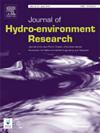Assessment of the impact of greenhouse rainwater harvesting managed aquifer recharge on the groundwater system in the southern Jeju Island, South Korea: Implication from a numerical modeling approach
IF 2.3
3区 环境科学与生态学
Q2 ENGINEERING, CIVIL
引用次数: 0
Abstract
Managed aquifer recharge (MAR) is increasingly being adopted worldwide to mitigate groundwater depletion and ensure the sustainability of water resources. Rainwater harvesting (RWH)-MAR can augment aquifer storage and reduce flood damage in rural areas with dense greenhouse facilities. This study has assessed the feasibility of greenhouse RWH-MAR in Namwon agricultural areas in the southern part of Jeju Island, South Korea, by considering the injection rate and location of MAR using a numerical model. The model results showed that groundwater level increases were directly related to the infiltration rate, although spatial differences in head rise were observed owing to the spatial variability of hydraulic conductivity. In addition, installing the RWH-MAR in highland areas (>100 masl) enhanced the water level rise when compared to the expected values, indicating that a higher hydraulic gradient and thick unsaturated zone facilitated more effective MAR outcomes than in lowland areas. To optimize the contribution of source water to the agricultural water demand, placing the RWH-MAR near the pumping well improved the availability of injected rainwater to agricultural wells. This study highlights the importance of designing RWH-MAR schemes considering MAR objectives and the topographic and hydrogeological characteristics of the site.
评估温室雨水收集管理含水层补给对韩国济州岛南部地下水系统的影响:数值模拟方法的启示
为了缓解地下水枯竭,确保水资源的可持续性,全世界越来越多地采用含水层管理补给(MAR)技术。在温室设施密集的农村地区,雨水收集(RWH)-MAR 可以增加含水层储量,减少洪水灾害。本研究利用数值模型,通过考虑雨水收集-MAR 的注入率和位置,评估了韩国济州岛南部南原农业区温室雨水收集-MAR 的可行性。模型结果表明,地下水位的上升与渗透率直接相关,但由于水力传导性的空间变化,水头上升存在空间差异。此外,与预期值相比,在高地地区(100 m²)安装 RWH-MAR 可提高水位升幅,这表明与低洼地区相比,较高的水力梯度和较厚的非饱和带可促进更有效的 MAR 成果。为了优化源水对农业用水需求的贡献,将 RWH-MAR 设在抽水井附近可提高农业水井对注入雨水的可用性。这项研究强调了在设计 RWH-MAR 方案时考虑 MAR 目标以及现场地形和水文地质特征的重要性。
本文章由计算机程序翻译,如有差异,请以英文原文为准。
求助全文
约1分钟内获得全文
求助全文
来源期刊

Journal of Hydro-environment Research
ENGINEERING, CIVIL-ENVIRONMENTAL SCIENCES
CiteScore
5.80
自引率
0.00%
发文量
34
审稿时长
98 days
期刊介绍:
The journal aims to provide an international platform for the dissemination of research and engineering applications related to water and hydraulic problems in the Asia-Pacific region. The journal provides a wide distribution at affordable subscription rate, as well as a rapid reviewing and publication time. The journal particularly encourages papers from young researchers.
Papers that require extensive language editing, qualify for editorial assistance with American Journal Experts, a Language Editing Company that Elsevier recommends. Authors submitting to this journal are entitled to a 10% discount.
 求助内容:
求助内容: 应助结果提醒方式:
应助结果提醒方式:


